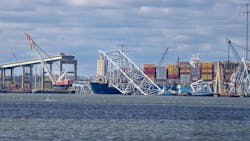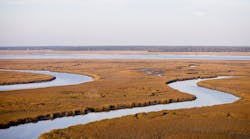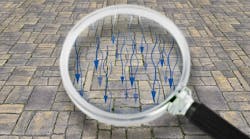How the Francis Scott Key Bridge collapse could impact water quality
Sited at the northwest branch of the Patapsco River in Chesapeake Bay, the Baltimore Port is one of the top 20 ports in the United States. Spanning the river is the Francis Scott Key Bridge, named for Maryland attorney Francis Scott Key, who, during the Battle of Baltimore, witnessed the 1814 British bombardment of Maryland's Fort McHenry in the War of 1812 and was inspired to write the ‘Star-Spangled Banner.”
Noted as an engineering landmark, the Francis Scott Key Bridge was the second-longest truss bridge span in the U.S. and third in the world. The four-lane bridge that opened in 1977 was the final link to Interstate 695/Baltimore Beltway that connected to I-95, the main east coast north-south Maine- to- Miami corridor.
Key would have never imagined the eponymous named mile-long bridge of the future, nor the port that would grow to national economic significance. But 210 years later, his namesake was the scene of tragedy. After losing power at least twice, the Singapore-flagged container ship MV Dali hit the bridge on March 26, 2024, causing its collapse in 40 seconds and the death of six people. All maritime traffic was blocked until mid-June while salvage crews worked to remove enough wreckage from the 984- foot vessel to allow channel re-opening.
Rebuilding the bridge
However, the demolition and subsequent rebuilding of the Key Bridge presents special concern to the Chesapeake Bay Foundation (CBF) as Allison Colden, Maryland executive director of the foundation explains.
"Our organization, which is the largest regional conservation group dedicated to saving the Bay, also recognizes the huge national and regional economic importance of the Port of Baltimore. Many folks are not aware that the Chesapeake Bay is the largest estuary in the U.S. with 64,000 square miles and nearly 12,000 miles of coastline."
Further, the Bay's average depth is 21 feet, and 25% of the Bay is 6 feet or less.
With the draft of most cargo ships entering the harbor at 50 feet, this is cutting it close.
"Maintaining these federal navigation channels to keep things moving requires tremendous dredging effort," Colden said. "Now, with this tragic bridge collapse, we have some concerns about the environmental impact and disturbance of sediments - from both the demolition and the rebuilding perspective.”
Professor Jeff Cornwell, PhD., University of Maryland Environmental Sciences Center (UMCES) and expert on marine nutrients and sediments, provides some Harbor backstory for these concerns.
The Port of Baltimore, which was originally founded on the Patapsco River in 1706, grew from a center of colonial tobacco trade and with its prime location for trans-Atlantic export, became the home to industry, said Cornwell.
"These included oil refining, copper smelting, steel production and chrome ore (chromium) processing,” he said. “This left vast areas of the harbor area contaminated and that contributed to hazardous waste runoff for decades until regulations mandated permanent cleanup solutions."
Cornwell adds that his group previously performed a study of the Patapsco's surface sediment to learn about its current status.
"When you look at the metal concentration at the surface, it's not off the scale. But, if you go down a meter what you see are legacy toxins, particularly from WWII shipbuilding here,” he said. “At the time they couldn't build ships fast enough, and there was a minimum of concern over contamination, so you can still find massive amounts of lead and lots of other heavy metals."
Colden agrees that prior to the bedrock laws of the Clean Water and Clean Air Act contaminating pollution was the rule not the exception.
"Now, if we are disturbing these sediments and causing them to be resuspended, we could have serious impacts,” Colden said. “This includes the potential for endocrine disruptors in the marine life-- fish, oysters, crabs --and then once that occurs, these enter the human food chain and become a public health hazard. This would have an impact not only on aquatic resources but the communities surrounding the harbor who experience nuisance flooding, sunny day flooding based on climate change and other factors. The health of those communities who may come into contact with those waters could be at risk."
Cornwell says that according to their maps of contamination spots, this one is not a hot spot, and is fortunately, one of the cleaner places. However, he adds that the Maryland Department of Transportation will have to do a lot of technical testing for the Environmental Impact Statement (EIS) to characterize the material under the surface where they will build the new bridge.
"They want to do the right things, and I don't see significant issues as the data collected will be transparent and nothing will be hidden. The EIS generated will be a huge book, and as part of it they will have a massive amount of characterization," Cornwell says.
Business in the port
Baltimore is the country's leading port in roll-on/roll-off ,”which means they drive EU cars onto the carriers, and drive them off," Cornwell said, explaining that the port is the primary destination for European cars entering this country for sale. He adds the port is a leading exporter of farm equipment and 10th largest port for dry bulk, like sugar.
This importance of the port to the national economy puts tremendous pressure on officials to complete the demolition and replace the bridge. But rushing that work could have consequences, and Colden cautions, "We don't want that to happen at the expense of the Environment."
But she points out that, "this is also an opportunity to be forward looking to building something better."
Nearly 50 years of innovations in technology and environmental science since the bridge opened can be used for those solutions.
"We know a lot more now about best practices and Baltimore Harbor has been improving; the water quality has been improving long term and we don't want to backtrack,” Colden said. “Building a new structure of this magnitude requires rethinking the bridge design, the stormwater options, reducing runoff from such a large structure, and considering new transportation options."
Collaborating on the rebuilding process
According to data by the Bureau of Transportation Statistics, the Francis Scott Key Bridge carried 12.5 million vehicles in 2023, averaging more than 34,000 vehicles a day -equivalent to a line of cars from Washington D.C. to Philadelphia. The bridge was also the sole artery allowing hazardous materials transport, but those vehicles are prohibited from using the Harbor tunnels. Now, those trucks must make 30 miles of detours incurring additional fuel expense.
"Roadways account for the third largest impervious surface in the state, and the State Highway Administration is responsible for the building and maintenance of those surfaces," Colden said. "It's our belief that this tragedy can be turned into an opportunity from several perspectives: build better structures, address the contaminants from all the oils and debris that thousands of vehicles contribute daily to the runoff, and rethink transportation objectives."
Ideally, Colden said she would like the rebuilding process to include the input of all stakeholders.
"We must take into account what we know about best practices and plan the future going forward to bolster the safety and security of the bridge, as well as the surrounding communities,” she said.
Editor's note: This story was updated to reflect the correct depth of the Chesapeaker Bay on July 15, 9:13 a.m. EST.




